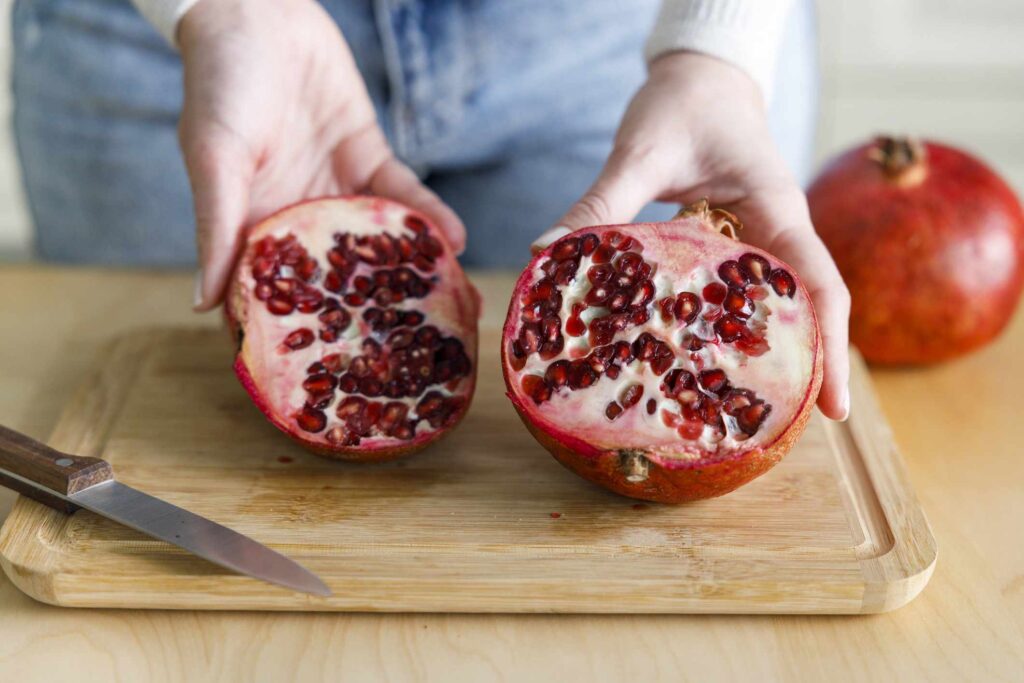When you open a pomegranate fruit (Punica granatum), you will see the fruit’s seeds, which are edible and contain nutrients.
Pomegranate seeds are small, bright red, and juicy, with a taste ranging from tangy to sweet and berry-like. In the fall and winter, you can easily find fresh pomegranates in most grocery stores.
Pomegranate seeds can be hard to remove, but using the proper technique can make it easier.
Steps for cutting a pomegranate and removing the seeds include:
- Cut the top: Use a sharp knife to cut off the top of the pomegranate (the stem area) and remove the top piece. You should see that the white membranes (pith) divide the seeds into sections.
- Score it: The pomegranate will open, but the seeds will remain together in sections.
- Remove seeds: Hold the pomegranate over a large bowl, and use your fingers to remove the seeds.
- Remove pith: The pith may come along while removing the seeds. You can remove it by filling the bowl with water. The pith will float, while the seeds will sink.
Incorporating pomegranate seeds into your diet is a great way to boost both nutrition and flavor. Here are a few tasty ideas:
- Blend them with pineapple, banana, raspberries, and almond milk for a tropical fruit smoothie.
- Top them on a mixture of pomegranate juice, lemon juice, and coconut water that’s been into a slush.
- Add them to Greek yogurt along with granola and coconut.
- Sprinkle them over oatmeal with nut butter, chia seeds, and honey.
- Toss them into a mixed green salad with sliced oranges, crumbled goat cheese, and sliced almonds.
Pomegranate seeds do not have the protection of the fruit peel, so they tend to spoil faster. You can store pomegranate seeds for up to 21 days at 39-43 degrees Fahrenheit (4-6 degrees Celsius).
You can freeze leftover pomegranate seeds to help them last longer. Freezing foods below 0 degrees Fahrenheit (-18 degrees Celsius) stops bacterial growth. The quality decreases over time, which changes the color, taste, and smell.
Pomegranates are in season during the fall and winter. When choosing a pomegranate, things to keep in mind include:
- Buy local: Local produce can sometimes have a longer shelf life than produce that goes through shipping.
- Check for damage: Fruits can be damaged during transport, which can speed up damage and bacterial growth.
- Feel for firmness: Look for less firm fruits. Avoid overripe pomegranates, which may have soft, dull-colored skin with brown spots.
- Look at the color: Pomegranates turn from green to red as they mature. While ripening, antioxidants give the fruit its red color.
You can also find ready-to-eat pomegranate seeds fresh, freeze-dried, or frozen. Tips for buying pomegranate seeds include:
- Buy frozen products last: Pick up frozen pomegranate seeds as your last item to prevent them from melting.
- Check the date: Always check the “best buy” or “use by” date to avoid low-quality or soon-to-expire foods.
- Examine the package: The packaging should not be broken, have tears or holes, or appear discolored. Avoid items that are softening or have ice crystals.
- Read the label: Frozen or pre-packaged fruits may contain other ingredients. Make sure the product is 100% pomegranate seeds without added sugars.
Pomegranate seeds are rich in fiber, vitamin C, and potassium. They also contain phenolic compounds, which may lower inflammation, blood pressure, blood sugar, and cholesterol levels.
Experts recommend at least two servings of fruit a day. A standard half-cup serving of pomegranate seeds has nutrients like:
- Calories: 60
- Fat: 0.25 grams (g), or 0.32% of the Daily Value (DV)
- Sodium: 2.8 milligrams (mg), or 0.12% of the DV
- Carbohydrates: 13.5 g, or 4.91% of the DV
- Fiber: 5.5 g, or 19.64% of the DV
- Added sugar: 0 g
- Protein: 1 g, or 2% of the DV
Pomegranate seeds are generally safe to eat. However, risks to keep in mind include:
- Allergies: Although uncommon, some people have allergies to pomegranates.
- Digestive discomfort: You may develop diarrhea if you eat too many pomegranate seeds at once.
Choosing a ripe pomegranate and using the proper technique can remove the seeds quickly and easily. You can also buy pomegranate seeds in fresh or frozen form at the market.
Pomegranate seeds are rich in antioxidants, fiber, vitamin C, and potassium. You can add the seeds to your diet by incorporating them into salads, oatmeal, yogurt, smoothies, and more.


